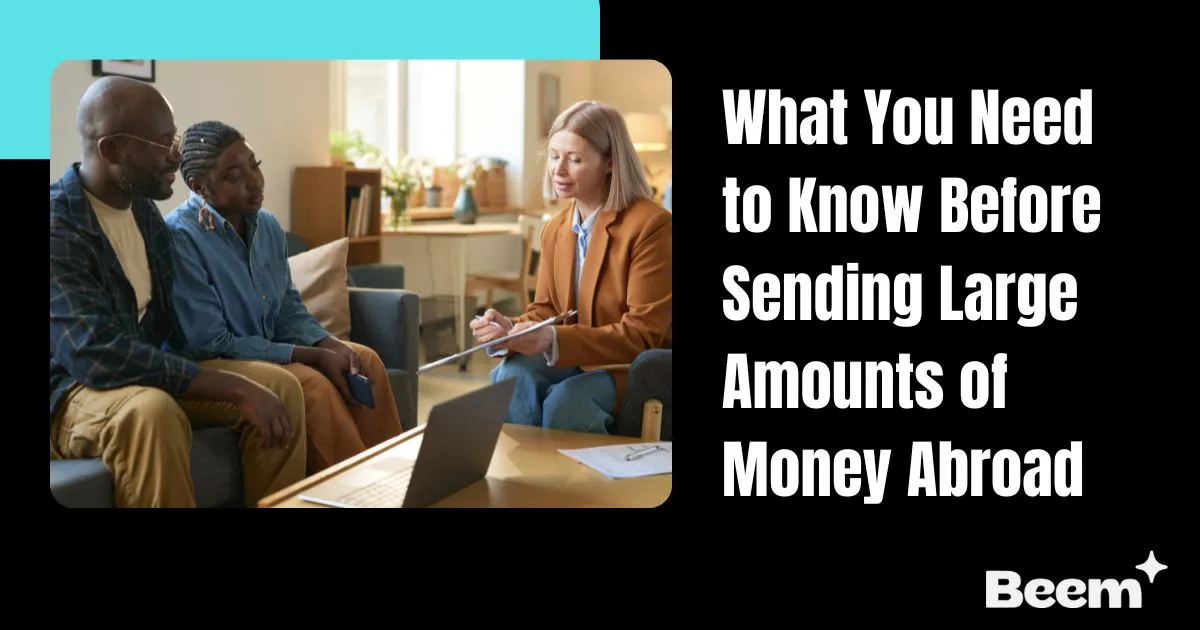At A Glance
In our globalized world, sending money internationally is often required to support family, invest, buy property, or manage business operations. But when it comes to sending large amounts of money abroad, the stakes are much higher. Mistakes, oversights, or scams can cost you thousands; even a small error can lead to delays, lost funds, or legal trouble.
If you’re in the United States of America and planning a major international transfer, it’s critical to approach the process with caution and awareness. Here’s a comprehensive guide to ensure your money gets where it needs to go safely, efficiently, and legally.
1. Understand the Legal and Regulatory Landscape
Before initiating any large international transfer, familiarize yourself with the US’s legal requirements and reporting obligations.
Reporting Requirements
- IRS Reporting: Large transfers may need to be reported to the IRS, especially if they exceed certain thresholds or are considered gifts. For example, sending over $10,000 may trigger mandatory reporting, and gifts above $18,000 per recipient (as of 2025) may require a gift tax return (Form 709).
- FinCEN and OFAC: The Financial Crimes Enforcement Network (FinCEN) and the Office of Foreign Assets Control (OFAC) monitor large international transfers to prevent money laundering and terrorist financing. Transfers above $10,000 can be flagged, and certain countries may be subject to sanctions or restrictions.
- Bank Reporting: US banks must report transactions over $10,000, and may request additional documentation for large or unusual transfers.
Why This Matters
Failure to comply with legal requirements can result in penalties, frozen funds, or even a criminal investigation. If you’re unsure about the rules, always check with your bank or a financial advisor.
2. Choose the Right Transfer Method: Don’t Just Default to Your Bank
There are several ways to send large sums abroad, each with distinct pros and cons:
Bank Wire Transfers
- Pros: Secure, direct, and widely accepted.
- Cons: Often expensive (fees can exceed $50 per transaction), slow (2–5 days), and subject to poor exchange rates and hidden fees.
- Caution: Double-check all recipient details; errors are difficult to reverse.
Online Money Transfer Services
- Examples: Wise, Revolut, OFX, Remitly, and others
- Pros: Lower fees, better exchange rates, faster delivery.
- Cons: Limits on transfer amounts, may require additional verification for large sums.
- Caution: Only use regulated, reputable providers. Look for licensing, customer reviews, and clear fee disclosures.
Fintech and Digital Wallets
- Pros: Fast, convenient, often app-based.
- Cons: Not all support large transfers or all countries.
- Caution: Ensure the platform is FDIC-insured or similarly regulated.
Checks and Demand Drafts
- Pros: Useful for specific countries or situations.
- Cons: Slow (can take weeks), higher risk of loss or fraud, less transparency.
- Caution: Avoid urgent or high-value transfers.
Cash Transfers
- Pros: Immediate pickup in some cases.
- Cons: High fees, risk of theft or loss, strict limits.
- Caution: Not recommended for large amounts.
Tip: Always compare your options before sending money. Use a comparison tool or consult your financial institution to find the best method for your needs.
Also Read: How to Send Money to Multiple Countries at Once From USA
3. Beware of Hidden Costs and Exchange Rate Markups
One of the most common pitfalls in international money transfers is underestimating the actual cost. Here’s what to watch for:
Fees
- Sending Fees: These are charged by your bank or transfer service, often $10–$50 or more for large transfers.
- Receiving Fees: The recipient’s bank may also charge a fee (commonly $10–$20).
- Intermediary Fees: If your money passes through intermediary banks (a common practice in SWIFT transfers), each may deduct a fee.
Exchange Rate Margins
- The Real Cost: Banks and some services offer less favorable exchange rates than the mid-market rate, pocketing the difference.
- Small Differences, Big Impact: On a $50,000 transfer, a 2% margin means $1,000 lost to the exchange rate alone.
Taxes and Other Charges
- Conversion Taxes: Some countries impose taxes on currency conversion.
- Service Taxes: Additional service charges may apply depending on the provider and the countries involved.
When sending large amounts of money abroad, always request a full breakdown of fees and the exact exchange rate before confirming your transfer. Reputable services provide transparent pricing and real-time rate quotes.
4. Security and Fraud Prevention: Don’t Become a Statistic
Large international transfers attract scammers and fraudsters. Here’s how to protect yourself:
Common Scams
- Phishing: Fraudsters may pose as banks or transfer services, asking for sensitive information.
- Fake Providers: Unregulated or fake websites may steal money or personal data.
- Impersonation: Scammers may impersonate the recipient or send fake invoices.
How to Stay Safe
- Verify the Provider: Use only well-known, regulated services. Check for licensing and read independent reviews.
- Double-Check Details: Always confirm recipient account numbers, SWIFT/BIC codes, and names. A single typo can send your money into a black hole.
- Secure Your Devices: Use strong, unique passwords and enable two-factor authentication on your accounts.
- Never Share Sensitive Info: Don’t share PINs, passwords, or one-time codes with anyone.
If something feels off, pause and verify before proceeding. When in doubt, consult your bank or a trusted financial advisor.

5. Documentation and Paper Trail: Keep Everything
When sending large sums, meticulous record-keeping is your best friend.
What to Keep
- Receipts and Confirmations: Save digital and paper copies of all transfer confirmations.
- Correspondence: Keep emails, chats, or letters with your provider and recipient.
- Bank Statements: Download statements showing the transfer and any associated fees.
Why It Matters
- Proof in Case of Disputes: If your funds are delayed, lost, or challenged, documentation is vital for tracing and recovering your money.
- Tax and Legal Compliance: You may need documentation for IRS reporting or if questioned by authorities.
Tip: Store all documents securely, both digitally (backed up) and in hard copy.
Also Read: A Quick Guide to Sending Money Across Borders Using Your Bank
6. Timing and Transfer Delays: Plan for the Unexpected
International transfers, especially large ones, are often subject to delays and additional scrutiny.
Why Delays Happen
- Compliance Checks: Banks may hold funds for anti-money laundering (AML) or know-your-customer (KYC) reviews.
- Bank Holidays: Different countries have different banking schedules.
- Intermediary Banks: Transfers routed through multiple banks can take longer.
How to Prepare
- Start Early: Initiate transfers well before deadlines (property closings, tuition payments, etc.).
- Notify Your Bank: Tell your bank about large, unusual transfers.
- Track Your Transfer: Monitor progress by using tracking numbers (like SWIFT MT103) and online banking tools.
If your transfer is delayed, contact your provider immediately and request a status update or investigation.
7. Tax Implications and Reporting: Don’t Get Caught Off Guard
Large international transfers can trigger tax obligations or reporting requirements.
US Tax Rules
- Gift Taxes: If you’re sending a gift over $18,000 (2025 threshold), you must file Form 709 with the IRS.
- Foreign Account Reporting: If you hold or transfer large sums to a foreign account, you may need to file an FBAR (FinCEN Form 114) or FATCA Form 8938.
- Income Reporting: If the transfer is related to income (salary, investment returns), you may owe US taxes.
Recipient Country Rules
- Local Taxes: The recipient may be subject to local taxes or reporting requirements.
- Double Taxation Treaties: The US has treaties with many countries to avoid double taxation. Check if one applies to your situation.
Consult a tax professional before sending large sums, especially if you’re unsure about the US or destination country rules.
8. Tips for a Safe and Smooth Transfer
Here’s a checklist to help you avoid costly mistakes:
- Double-Check Recipient Details: Names, account numbers, and bank codes must be 100% accurate.
- Start Small: Send a small test transfer before sending the full amount.
- Use Secure Networks: Avoid public Wi-Fi when initiating transfers.
- Communicate Directly: If you’re sending money for a transaction (e.g., buying property), confirm details directly with the recipient-never rely solely on email instructions.
- Monitor Your Accounts: Watch for unauthorized activity before and after your transfer.
Always use reputable, regulated providers for international money transfers for a seamless, transparent, and secure experience.
9. What to Do If Something Goes Wrong
Despite your best efforts, problems can occur when sending large amounts of money abroad. Here’s how to respond:
If Your Transfer Is Delayed or Lost
- Contact Your Provider: Ask for a status update and tracking information.
- Request an Investigation: For SWIFT transfers, ask for an MT103 document to trace the funds.
- Escalate If Needed: If the provider is unresponsive, escalate the issue to your bank’s compliance department or file a complaint with the Consumer Financial Protection Bureau (CFPB).
If You Suspect Fraud
- Act immediately: Contact your bank and the transfer provider to freeze the transaction.
- Report to Authorities: File a report with the FBI’s Internet Crime Complaint Center (IC3) and the Federal Trade Commission (FTC).
- Change Passwords: Update login credentials for all related accounts.
Also Read: How To Send Money Abroad In 5 Easy Steps
Conclusion: Caution Is Your Best Friend
Sending large amounts of money abroad isn’t just about clicking “send.” It’s about understanding the risks, complying with the law, and choosing the safest, most cost-effective method for your needs. Always approach large international transfers with caution-verify every detail, keep meticulous records, and use only reputable, regulated providers.
When in doubt, pause and verify before you send. A few extra minutes of caution can save you thousands of dollars.
Before starting your next transfer, consult your financial institution or a trusted advisor for more tips on safe and efficient international money transfers.
Apps like Beem offer a modern solution for sending money abroad with its Send Now, Pay Later™ feature, giving users flexibility and speed when supporting loved ones across borders. Download the Beem app here.






